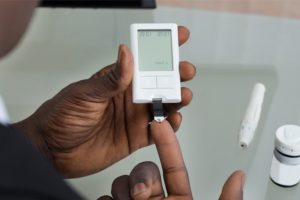
The following was originally published in Johns Hopkins Medicine’s Fundamentals.
With the country shifting focus from COVID-19 infections to immunity, people need to know how protected they are against the illness.
That information could be right at their fingertips, literally.
A team of scientists at Johns Hopkins Medicine found a way to use common glucose meters, like the ones that many people with diabetes use, to measure the level of COVID-19 antibodies a person has in their blood. Antibodies are proteins created in response to a disease, and remain in the body to fight the next encounter.
The researchers’ latest findings were published June 8 in the Journal of the American Chemical Society.
“It’s an important tool because knowledge is power,” said Jamie Spangler, Ph.D., assistant professor of biomedical engineering and chemical and biomolecular engineering, who was one of four Johns Hopkins scientists to develop the glucose monitor approach. “And in particular, knowledge about your health can empower you to make appropriate decisions about how you’re going to protect yourself against biological threats.”
Currently, to get a COVID-19 antibody test, people have to get their blood drawn at a health care facility. But Spangler and others on the team wanted to create a test that was more affordable, accessible and easy to use that would also help people and policymakers make more informed decisions about mask-wearing, booster vaccinations and public safety measures.
“We’re proponents of democratizing diagnostics by giving you the freedom to test yourself and monitor yourself in a quantitative way,” said Netz Arroyo, Ph.D., assistant professor of pharmacology and molecular sciences, another inventor of the new approach.
The researchers have obtained a provisional patent with the help of Johns Hopkins Technology Ventures, and are reaching out to biotechnology companies to commercialize the technology. Arroyo said the team had commercial interest even before they published the paper.

Netz Arroyo, left, and Jamie Spangler
They chose a glucose meter as the detection device because many pharmacies across the country sell them fairly inexpensively, unlike the expensive equipment many health care facilities must use to measure antibody levels. It also gives a digital readout, making the results easy to interpret.
Arroyo, Spangler and the others are trying to simplify the test for commercial use. But the process aligns closely with how people with diabetes use the glucose meter.
The researchers coated the “spike” protein from SARS-CoV-2, the virus that causes COVID-19, onto a glucose monitoring test strip that they designed.
The first step is to add a drop of blood to the strip. Spike protein-targeted antibodies from the blood then bind to the strip. Next, the strip is dipped into an enzyme bath, where the enzymes and antibodies bind. Then, the strip is dipped into a new solution full of the sugar sucrose, and the enzyme breaks the sucrose down into glucose.
Finally, the glucose meter tests for glucose, which is proportional to the level of COVID-19 antibodies.
In the recent study, the researchers tested serum samples from at least six people who had COVID-19 and were treated at The Johns Hopkins Hospital and at least six people who tested negative for the virus.
The team found that the glucose-based test was on par with the gold-standard detection method used at health care facilities, pharmacies and testing sites, specifically the enzyme-linked immunosorbent assay (ELISA). The investigators tested the same samples with the glucose monitor test and the industry standard test. They observed a 95% positive and a 96% negative agreement. This means the two tests showed very similar results when testing for samples that were positive and negative for COVID-19.
In the past, glucose meters have been studied as a means for measuring other chemicals besides sugar. But previous studies ran into a common problem.
The challenge was to make a protein that could simultaneously measure the number of antibodies and convert the signal into glucose, so it could then be measured by the glucose meter. To do this, they merged the antibody and enzyme chemically, but the efficiency of the process was too low to be scalable to population-level screening.
“So, we thought, if we want to innovate, that’s what we need to overcome,” said Arroyo.
Instead of merging the two proteins chemically, the team realized they needed to merge them genetically into a new protein.
“We created something new, something that is not biologically existent in the world right now,” Arroyo said.
However, the researchers want to see what else the glucose-based test can do first. The test not only works for a range of COVID variants but also, potentially, for any disease that produces antibodies in the blood. All they need to do is switch the disease’s correlating protein on the test strip.
“We still think we can improve the reagent and do more with it, and so a part of the process we’re undergoing right now is to see if we can make it even better,” Arroyo said. “And the better we make the reagent, the more commercial interest we’ll get.”
The team is planning on doing additional studies to simplify the test’s process and analyze its versatility.
“It was just so exciting to be a part of this and to really feel like we’re doing work that has an immediate, direct impact on public health,” Spangler said.